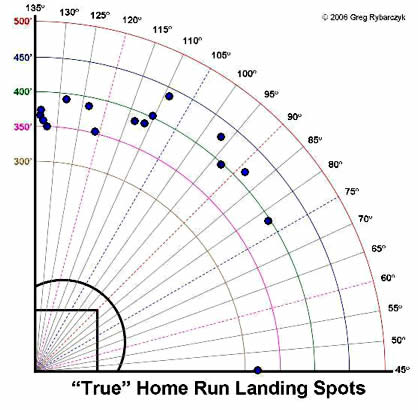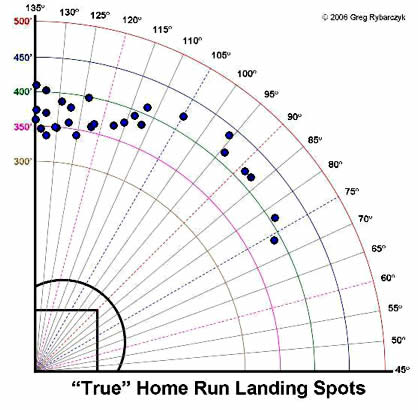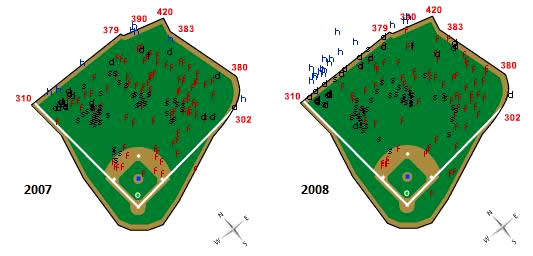BP Comment Quick Links

 | |
March 26, 2009 Fantasy BeatAnd It's Gone!
Home runs are one of the most exciting parts of a baseball game. They're the fastest way to score a run, and unlike moving baserunners from station to station, they happen in an instant, causing fans instant joy or equally instant sorrow. There is a reason that Mark McGwire and Sammy Sosa are said to have "saved" baseball back in 1998, as fans who had left the game behind following the '94 strike flocked back to watch home-run records being set. It's no surprise then, that we often overrate players based on their home-run totals. I'm not saying that hitting a lot of home runs is a bad thing-you should see a list of some of my favorite players sometime, as it includes some one-tool power beasts. I'm talking more about how quickly we accept a player's highest home-run total as their standard level of production, whether it happened a few years ago or in the previous season. Here's an example, though the player in question is less important than the overall lesson: many people have jumped on Kevin Youkilis as a serious power-hitting first baseman because he launched 29 homers last year, 13 more than he had ever hit before in a single season. If you're looking for reasons for his dramatic increase, you'll be hard-pressed to find anything valid or persuasive, however. Many people have just assumed that he has now established a new performance level, when in reality there are a few issues with Youkilis' season that warrant attention, and his case is actually a lesson in how to analyze power hitters. If suddenly last summer a 29-year-old hitter began hitting for more power, you would think that there would have been a significant change in his approach. However, this was not the case with Youkilis, as very little changed. He took fewer pitches than he normally does-4.3 pitches per plate appearance in 2007, down to "just" 4.0 in 2008-and he swung at more pitches outside of the zone, up from 17.4 (his previous high) to 22.3 percent. That's about it. He didn't make significantly more contact overall because of the added swings, but instead gained a few homers and lost some walks. The extra home runs may not be due to these slight changes; while Youkilis' HR/FB rate climbed from 8.4 percent to 14.9, all of his other batted-ball figures remained relatively static, including his fly-ball rate (44.7 to 44.2 percent). He even hit about the same number of popups per fly ball, so there's little evidence to suggest that he made any modifications to his swing that would have caused his power numbers to erupt. All of this brings us to Hit Tracker, a website dedicated to tracking home runs in ways that you never even thought of. Homers and their distances are adjusted for a variety of elements, including wind speed/strength, and the temperature (the ball does not fly as far in cold weather as it does in warm weather). There are four types of home runs listed at Hit Tracker: "Just Enough" homers, which barely cleared the fence on both a horizontal and vertical level, "No Doubt" homers, which are the serious bombs that clear the fence and then just keep on traveling, "Plenty" home runs, which is basically everything else except for those two types, and then "Lucky" homers, which are ones that, had the ball been hit in 70-degree weather with calm winds, would not have left the park. Getting back to Youkilis, we see that he hit 12 homers in the "Just Enough" category last season. Remembering that he hit 13 more home runs than he ever had before in a single season, it looks rather obvious where a lot of those extra homers came from. The exact definition of a "Just Enough" home run is as follows: Means the ball cleared the fence by less than 10 vertical feet, OR that it landed less than one fence height past the fence. These are the ones that barely made it over the fence. When we look at Youkilis' 2007 season in chart form, we see where his homers were concentrated:
 Youkilis hit a small number of long-distance homers in '07, mostly utilizing the short porch in left with towering fly balls for his homers. As for 2008:
 This scatter plot looks very similar, except there are more of the blue dots representing homers in the short portion of left field. You can even see a few stacked on top of each other, ones that, given their distance, were most assuredly compliments of the Green Monster. There is more to look at than just the charts at Hit Tracker, however. You can see how much wind affected a hitter's home runs, calculated by the feet that were gained or lost due to the power of the wind. For Youkilis, eight of his homers in '08 earned at least another 14 feet from the wind, with the first five of those (ranging from 19 feet to 43 feet) coming at Fenway Park. That's how he hit a 345-foot home run off of Joel Pineiro on June 22, which, if not for the winds that day, should have been roughly a 300-foot fly ball that would have probably been caught by an outfielder. It also reached a height of 147 feet; when you combine those two elements, you see that the ball would have left the park in zero other instances. Boston is a very windy town, but in 2007 the wind was not working in Youkilis' favor as much. Just seven of his 16 homers received any wind support at all, and on a much smaller scale than in 2008 (ranging from a single foot to seven feet). Youkilis had 18 of his 29 homers boosted by the wind, though the other 10, like the ones in 2007, were more limited in bonus distance. Even his fly outs may have received some help, as shown in his Hit Charts from MLB.com:
 You can see how many of those home runs did clear the Monster, many at short distances, and you can also see that he hit a few more doubles over the heads of outfielders while seeing some deeper fly outs as well. The more you look at these charts and numbers, the more it appears that the wind had more to do with his power output than any other factor. This is not to say that Youkilis isn't a useful hitter, of course. In fact, given Fenway's nature and his own tendencies, I would venture to say that 20 home runs is a solid base to give him for power. PECOTA agrees, as his weighted-mean forecast is .276/.368/.478, with 21 homers and an ISO of .202; higher than his pre-2008 numbers, but not as much of a jump as that season would lead you to believe he has made. The important thing to take from this piece isn't so much the exact number of home runs that Youkilis is going to hit in 2009-if Boston is just as windy this year as last year, and in a way that boosts production, then we may see Youkilis take another shot at 30 bombs. What's important is the process used to identify just what kind of player Youkilis actually is, and what kind of home-run power you should expect from him given this information. It's easy to just assume that players have reached a new level of production because they had a career year, but if you want that extra edge in your fantasy league-or even to have the proper expectations about your favorite real-life team and players-then digging deeper and using invaluable information such as that at Hit Tracker is a great way to get started.
|
While I like the extra drilldown, this is the third time I've read about Youkilis's "Just Enough" home runs. Perhaps it would have been best if this article came first, and then the other articles that have been written were cited... or find a different player who experienced similar circumstances.
Again, as was mentioned in the article, Youkilis himself is not so much the important thing to take away here, but the process of identifying players like him in general is what you want to pay attention to.
Though I will say, I'll try to avoid reusing the same examples in the future if I put together a singularly focused piece like this again.